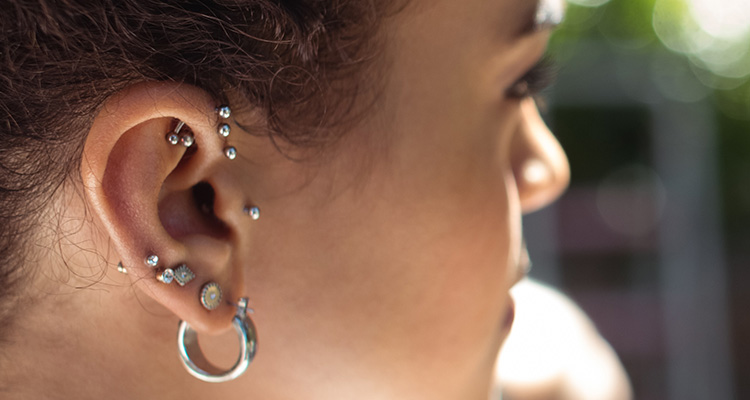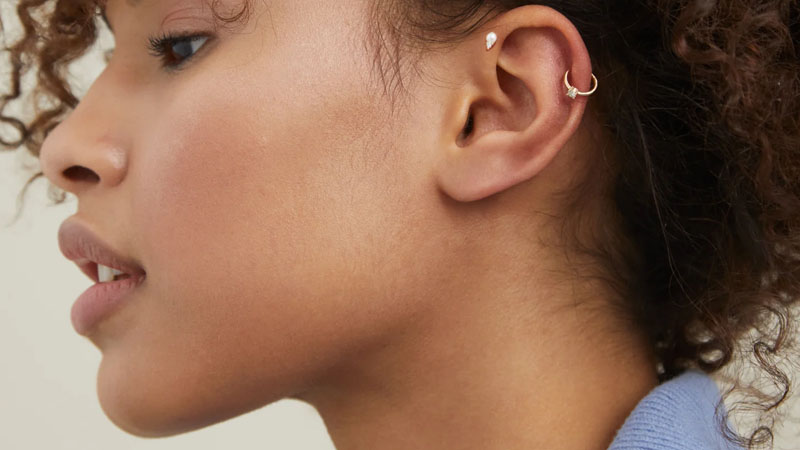07
Dec

There are various distinct types of ear piercings available from the earlobe up. A helix piercing, also referred to as a cartilage piercing, is one of the most popular kinds. You can easily customise this piercing, often done on the top ear, with various locations and jewellery designs. Whether it’s a slight touch or a dramatic statement, helix earrings are always placed towards the top of the ear, offering a simple method to change your style (look up the ears of Lily Allen, Cardi B, and Miley Cyrus, and you’ll see what I mean). Here’s all the information you need if you’re thinking of getting a helix.

The helix is the curled outer rim of the outer ear cartilage. You can place a helix piercing anywhere between the curve’s top and the earlobe’s beginning. There are other helix-piercing subcategories. Forwards helix piercings occur between the top of the curve and the tragus. Some people receive numerous helix piercings close together, known as double or triple helix piercings.
You may have heard the phrase cartilage piercing when referring to what was known as a helix piercing in the past. The term “cartilage piercing” is not misleading. However, the helix is only a minor component of the cartilage, which, on the other side, makes up most of the inner and outer ear. Tragus piercings, rook piercings, conch piercings, and daith piercings are other cartilage piercing types.
When getting your helix pierced, choose high-quality helix piercing earrings. Opt for solid gold, gold-filled or sterling silver piercing jewellery, which are the finest metals for earrings. Genuine gold earrings, in particular, are less prone to cause infection and are easy to clean properly.
Some people are sensitive to the metals used in lower-quality earrings, particularly nickel; Gold earrings are a safe pick because they are unlikely to induce an allergic reaction. After the wound has healed completely, you can switch to helix jewellery made from various materials unless you are sensitive to them.
Gold-fill jewellery, made with a thick coating of solid gold that has been pressure and heat-bonded to the base metal, commonly brass or sterling silver, is the closest thing to solid gold jewellery. That indicates that gold-fill jewellery has 5% solid gold, whilst gold-plated jewellery includes 0.05% solid gold. Gold Fill jewellery is far more robust and long-lasting; therefore, it’s an excellent choice for helix piercing earrings without breaking the bank.

Low-quality jewellery manufactured from inferior materials can cause allergic responses, skin irritation, and infections. Choosing hypoallergenic materials like sterling silver, gold fill, or solid gold helps to reduce these dangers, resulting in a comfortable and safe helix piercing experience. Quality helix piercing jewellery ensures lifespan and durability. Well-crafted pieces will last for years, enabling you to enjoy your helix piercings without worrying about breaking or tarnishing.
High-quality helix piercing jewellery comes in a wide range of styles, allowing you to choose the right match for your taste. Quality helix earrings boost your look and help you make a statement, from simple elegance to bold and elaborate designs.
It’s always preferable to begin a cartilage piercing using a stud. The piercing heals faster on a long, straight post than on a bent one. It also allows room for the irritation and swelling that occurs soon after the piercing, which is usual even when a professional does the piercing and you follow the aftercare instructions appropriately.
When the piercing has healed, you can replace the stud with a hoop or a style that suits your mood. Once you’ve decided on your first stud for your new helix piercing, follow the aftercare instructions provided by your piercer. To avoid infection, clean your piercing with the proper supplies.
Depending on your pain threshold, it ranges from four to seven on the pain scale. Any piercing, however, hurts because it’s just inserting a needle through the skin. Consider your pain level as well as the expertise and competence of your piercer to help lessen some of the discomfort.
Helix piercings often heal in three to six months. However, if you don’t properly care for your new piercing as it heals, it may take longer—or you may have to have it re-pierced and begin over. Wound healing varies from person to person, and it might take up to a year for some people to fully recover.
Washing the helix piercing twice a day with saline solution (or antibacterial soap) is all required for aftercare. The most challenging aspect of the process isn’t bathing; it’s doing everything you can to prevent aggravating your piercing. Avoid wearing beanies or headphones to reduce friction that might catch on your piercing. If you sleep on your side, you should sleep on the opposite side of your pierced ear, as resting on a fresh piercing might induce a bad reaction.
It’s also critical to avoid touching or irritating your piercing as much as possible, as irritation can lead to inflammation or, in certain situations, infection. If you must touch your piercing, wash your hands beforehand.